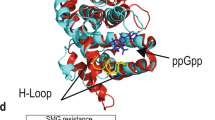Abstract
The response of the thermophile Bacillus stearothermophilus to inhibition of tRNA acylation, energy starvation and temperature downshift was characterized. We found that B. stearothermophilus, like other prokaryotic organisms, reacts with the so-called stringent response, which includes the accumulation of the unusual nucleotides guanosine 3′,5′ bis (dipphosphate) [ppGpp] and guanosine 3′-diphosphate, 5′-triphosphate [pppGpp] and concomitantly the reduction of RNA synthesis and growth rate. The amount of (p)ppGpp formed depended on the cause of the stringent response: when tRNA acylation was inhibited (p)ppGpp synthesis was much higher than after energy starvation or temperature downshift whereas RNA synthesis was totally blocked in each case.
Similar content being viewed by others
References
Boquet PL, Devynck M-A, Monnier C, Fromageot P, Röschenthaler R (1973) Inhibition of stable RNA synthesis by Levallorphan in Escherichia coli. Implication of compounds MS I and MS II. Eur J Biochem 40:31–42
Bridger WA, Paranchych W (1978) relA gene control of bacterial glycogen synthesis. Can J Biochem 56:403–406
Cashel M, Gallant J (1968) Control of RNA synthesis in Escherichia coli. I. Amino acid dependence of the synthesis of the substrates of RNA polymerase. J Mol Biol 34:317–330
Chaloner-Larsson G, Yamazaki H (1976) Synthesis of guanosine 5′-triphosphate, 3′-diphosphate in a spoT strain of Escherichia coli. Can J Biochem 54:935–940
Chaloner-Larsson G, Yamazaki H (1978) Effects of the spoT and relA mutation on the synthesis and accumulation of ppGpp and RNA during glucose starvation. Can J Biochem 56:266–272
Edlin G, Neuhard J (1967) Regulation of nucleoside triphosphate pools in Escherichia coli. J Mol Biol 24:225–230
Fiil NP, Willumsen BM, Friesen JD, von Meyenburg K (1977) Interaction of alleles of the relA, relC and spoT genes in Escherichia coli: Analysis of the interconversion of GTP, ppGpp and pppGpp. Molec Gen Genet 150:87–101
Gallant JA (1979) Stringent control in E. coli. Ann Rev Genet 13:393–414
Harshman RB, Yamazaki H (1972) MS I accumulation induced by sodium chloride. Biochemistry 11:615–618
Hansen MT, Pato ML, Molin S, Fiil NP, von Meyenburg K (1975) Simple downshift and resulting lack of correlation between ppGpp pool size and ribonucleic acid accumulation. J Bacteriol 122:585–591
Hölttä E, Jänne J, Pispa J (1974) The regulation of polyamine synthesis during the stringent control in Escherichia coli. Biochem Biophys Res Commun 59:1104–1111
Hughes J, Mellows G (1978) Inhibition of isoleucyl-transfer ribonucleic acid synthetase in Escherichia coli by pseudomonic acid. Biochem J 176:305–318
Irr J, Gallant J (1969) The control of ribonucleic acid synthesis in Escherichia coli II. Stringent control of energy metabolism. J Biol Chem 244:2233–2239
Kari C, Török I, Travers A (1977) ppGpp cycle in Escherichia coli. Molec Gen Genet 150:249–255
Khan SR, Yamazaki H (1974) Inapparent correlation between guanosine tetraphosphate levels and RNA contents in Escherichia coli. Biochem Biophys Res Commun 59:125–132
Kessler DP, Rickenberg JV (1963) The competitive inhibition of α-methylglucoside uptake in Escherichia coli. Biochem Biophys Res Commun 10:482–487
Ogilvie A, Wiebauer K, Kersten W (1975) Inhibition of leucyltransfer ribonucleic acid synthetase in Bacillus subtilis by granaticin. Biochem J 152:511–515
Rowe J, Goldberg ID, Amelunxen RE (1975) Development of defined and minimal media for the growth of Bacillus stearothermophilus. J Bacteriol 124:279–284
Silverman HR, Atherly AG (1979) The search for guanosine tetraphosphate (ppGpp) and other unusual nucleotides in eucaryotes. Microbiol Reviews 43:27–41
Sokawa Y, Nakao E, Kaziro Y (1968) On the nature of the control by RC gene in E. coli: Amino acid dependent control of lipid synthesis. Biochem Biophys Res Commun 33:108–112
Weyer WJ, de Boer HA, de Boer JG, Gruber M (1976) The sequence of ppGpp and pppGpp in the reaction scheme for magic spot synthesis. Biochim Biophys Acta 442:123–127
Yang H-L, Zubay G, Urm E, Reiness G, Cashel M (1974) Effects of guanosine tetraphosphate, guanosine pentaphosphate, and β-ψ methylenyl-guanosine pentaphosphate on gene expression of Escherichia coli in vitro. Proc Natl Acad Sci USA 71:63–67
Author information
Authors and Affiliations
Rights and permissions
About this article
Cite this article
Fehr, S., Richter, D. The stringent response to unacylated tRNA, energy- and temperature-downshift in Bacillus stearothermophilus . Arch. Microbiol. 129, 29–31 (1981). https://doi.org/10.1007/BF00417174
Received:
Accepted:
Issue Date:
DOI: https://doi.org/10.1007/BF00417174




